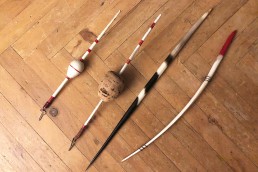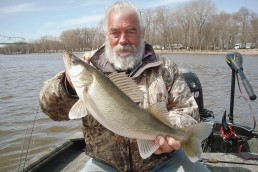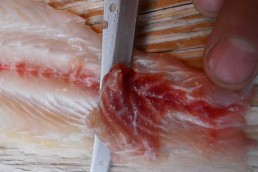Making Rigs Catch More in Cold Water and Year-round
SHARE THIS POST
Float rigs are the best way to catch fish in cold water and the rest of the year. This is true only when you balance the rig. I overheard this while working a booth at the fishing show: “I love these floats, been fishing them all my life. I lay them flat on the water and when they stand up, I can see I have a fish.”
If you fish floats on their side, you are missing the majority of bites. I know a few people do, and this is wrong. There was one float that was designed to be fished this way in the 1940s, but I don’t see any others that work best doing this.
Spot all the bites
This is a key concept, as only a balanced float will communicate all the types of bites. A float on its side cannot show a drop bite, a lift bite or bait hung on structure (bottom or weed). A balanced float will show the drop bite—when a fish intercepts the bait; a lift bite—when the fish picks up the hook bait and floats up—accounts for 20 to 30 percent of bites. Floats on their side will not show this. With a balanced float, I can see when my bait doesn’t reach depth if it lands on a weed or lies on bottom. The float never “sets” or cocks when the lowest weight or the hook bait lands on a weed if it is balanced and the depth is set. You will notice the float tilting, higher in the water or both if it the float is set right.
There are two types of rigs: those for pole (no reel), and rigs for casting floats (bobbers that don’t suck). Rigs have similarities for pole and for casting. (Rigs are the entire setup when finished – you can even buy pre-made rigs that just attach to the line for poles and short-distance casting). For casting floats, I see floats fished without enough weight on the line.
Weighty matters
Adding split shot to make your float ride low is the best way to increase bite detection. Ninety-five percent-plus of your float should ride beneath the water when the hook arrives at depth.
Are you enjoying this post?
You can be among the first to get the latest info on where to go, what to use and how to use it!
There are only a couple brands of split shot I use. Anchor Split Shot, Super Doux Split-Shot are the best.
Having more, smaller shot makes a better rig than a few, big shot. Using more shot to balance your float will make a more pleasing sound when it hits the water (to the fish), will communicate better and will be easier to make fine adjustments when changing bait kinds, or if wind goes up or down.
To best balance floats, you need a few different sizes of split shot. At least two sizes you should have BB (.4 gram) and a No. 4 (.2 gram) would be good to have on hand. You can buy a “standard” assortment with five or six sizes in both Anchor and Super Doux. Balance is key and it is easy. Simply stack the large split shot up the line in a row and test your float in a tube or tank. A flower vase is good to have. This top stack which lives beneath the float is called the “bulk” shot. It is the bulk of your balancing. To finish off your rig above the leader and a distance from the bulk shot, you add tiny shot on the bottom. This can be one or two very small shot and should be much smaller than the split shot used for the bulk.
This tiny shot is called the dust shot (tiny like dust) and this is the trigger to your float. On a pole float (used on telescopic poles), all the bulk shot is stacked under the float, a ways from the float stem. For casting floats, use three of the bulk shot to hold the float at depth. One shot on top of the shot (leading to reel) and two beneath will hold your float in place. Add distance from that and your bulk shot rides 6 inches to a foot from the float bottom. Then add another foot or more to the dust shot. When you pitch your float rig in or cast your spinning rig float out, your float will settle in the water (the bulk). The last action will be the tiny dust shot swinging down to depth. This cocks the float as it settles down into the water. This is the most important shot on your rig. It tells you everything and makes the float communicate.
With open water approaching, I will talk exclusively about smaller, more sensitive pole rigs in the next issue. After all, the smaller the float, the bigger the catch.
MWO
SHARE THIS POST
Did you enjoy this post?
You can be among the first to get the latest info on where to go, what to use and how to use it!
Johnny Wilkins
MidWest Outdoors works with more than 200 outdoor experts each year, who contribute articles based on their areas of expertise. MidWest Outdoors magazine offers more fishing and hunting articles than any other publication!



